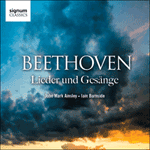
Welcome to Hyperion Records, a British classical label devoted to presenting high-quality recordings of music of all styles and from all periods from the twelfth century to the twenty-first.
Hyperion offers both CDs, and downloads in a number of formats. The site is also available in several languages.
Please use the dropdown buttons to set your preferred options, or use the checkbox to accept the defaults.

| John Mark Ainsley (tenor), Iain Burnside (piano)» More |
Unusually, Beethoven strives throughout to translate directly in musical terms what is actually being sung. He adopts an uncharacteristically flexible approach to tempo, especially in the opening section when the questioning of the first four lines finds resolve first in an Allegro affirmation (‘Hoffen soll der Mensch!’) and then in the gently flowing triplets of a dreamy Larghetto (‘Die du so gern in heil’gen’).
Beethoven also subtly colours the vocal line to heighten the meaning of the text (the second stanza’s ‘Den Dulder ahnen’, for example), and uses changes of tonality to enhance contrasting moods, as at the unexpected move down a major third at the start of the third stanza. He even makes abrupt changes of figuration to emphasize the poetic content, as at the third stanza’s mention of ‘Mitternacht’, where the accompaniment suddenly changes to gently agitated semiquaver triplets.
from notes by Julian Haylock © 1999
Fait rare, il s’efforce de traduire directement en termes musicaux ce qui est réellement chanté et adopte une approche inhabituellement flexible du tempo, surtout dans la section d’ouverture, où l’interrogation des quatre premiers vers trouve réponse d’abord dans une affirmation Allegro («Hoffen soll der Mensch!»), puis dans les doux triolets d’un onirique Larghetto («Die du so gern in heil’gen»).
Beethoven colore également de manière subtile la ligne vocale, afin de rehausser le sens du texte (ainsi «Den Dulder ahnen», dans la deuxième strophe), et recourt à des changements de tonalité pour mettre en valeur les atmosphères contrastées, comme à l’inattendue descente de tierce majeure, au début de la troisième strophe. Il réalise même de brusques changements de figuration pour accentuer le contenu poétique – ainsi, la mention de la «Mitternacht», à la troisième strophe, où l’accompagnement passe soudain à des triolets de doubles croches doucement agités.
extrait des notes rédigées par Julian Haylock © 1999
Français: Hyperion Records Ltd
Für Beethoven ungewöhnlich ist, daß er durchweg bestrebt ist, das Gesungene direkt in musikalische Begriffe zu fassen. Er geht untypisch flexibel mit den Tempi um, insbesondere in der Einleitung, wenn die in den ersten vier Zeilen bekundeten Zweifel zerstreut werden, erst mit einem bekräftigenden Allegro („Hoffen soll der Mensch!“), dann mit den sanft fließenden Triolen eines verträumten Larghetto („Die du so gern in heil’gen Nächten …“).
Darüber hinaus nuanciert Beethoven diskret die Gesangslinie, um die Bedeutung des Textes zu verdeutlichen (beispielsweise bei „Den Dulder ahnen“ in der zweiten Strophe) und benutzt Änderungen der Tonalität, um gegensätzliche Stimmungen zu verstärken, zum Beispiel mit dem unerwarteten Abstieg um eine große Terz zu Beginn der dritten Strophe. Er greift sogar zu jähen Wechseln der Figuration, um den dichterischen Gehalt zu betonen – so geschehen beim Wort „Mitternacht“ in der dritten Strophe, wo die Begleitung plötzlich zu leicht erregten Sechzehnteltriolen übergeht.
aus dem Begleittext von Julian Haylock © 1999
Deutsch: Anne Steeb/Bernd Müller
 Beethoven: Lieder und Gesänge Beethoven: Lieder und GesängeBeethoven was not a keen song writer, yet despite this almost half of his total works call for a voice. The present album includes some of the best of those compositions interpreted by accomplished tenor John Mark Ainsley and his accompanist Iain ...» More |

